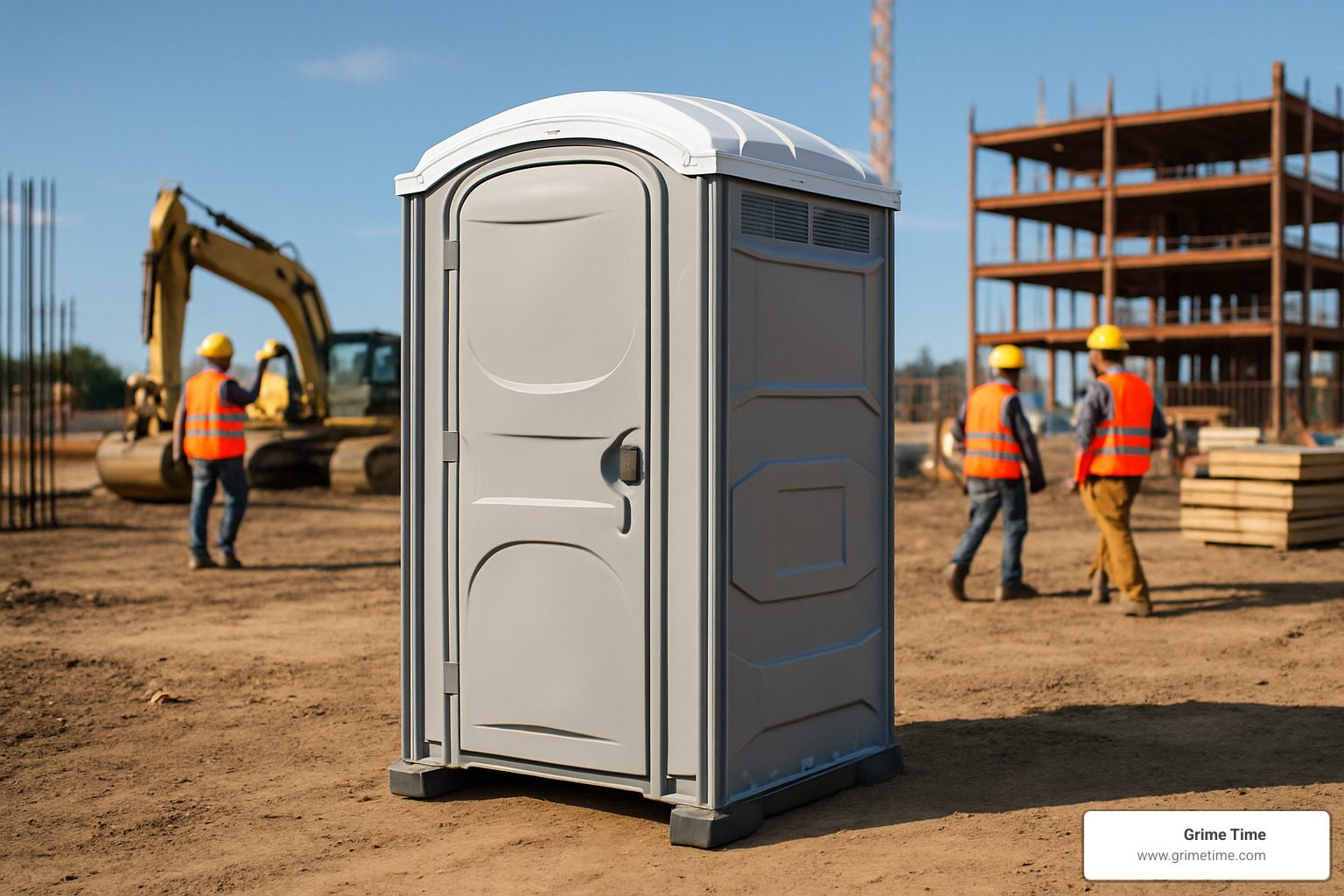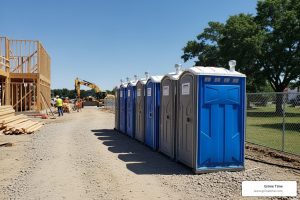Why Port a John Rentals Are Essential for Your Project
When nature calls at your construction site or outdoor event, a port a john is your reliable answer. These portable restrooms have become the go-to sanitation solution for contractors, event planners, and anyone needing temporary facilities where traditional plumbing isn’t available.
Quick Port a John Rental Guide:
- Standard units: $75-150/week for basic job sites
- Deluxe models: $125-250/week with sink and mirror
- ADA-compliant: $150-300/week for accessibility requirements
- Luxury trailers: $300-800/week for upscale events
- Capacity: 1 unit per 50 people for 4-hour events, 1 per 10 workers for 40-hour work weeks
The portable toilet rental market has exploded to over $15 billion globally in 2022, with Central Texas contractors and event organizers driving steady demand. Whether you’re managing a multi-week construction project or hosting a weekend festival, understanding your rental options saves time, money, and headaches.
Modern port a johns aren’t the smelly, uncomfortable boxes you might remember. Today’s units feature improved ventilation, better chemicals, and comfort upgrades that make them practical for extended use. The key is matching the right type to your specific needs and budget.
From basic jobsite units to climate-controlled luxury trailers, this guide breaks down everything you need to know about port a john rentals in Central Texas. We’ll cover types, sizing, placement, costs, and maintenance so you can make informed decisions for your next project.

Basic port a john vocab:
Port a John 101: Anatomy, History & Function

Ever wondered what makes a port a john tick? These clever little units pack centuries of bathroom innovation into a compact, portable package that’s revolutionized how we handle sanitation at job sites and events.
Think of a port a john as a self-contained bathroom ecosystem. The holding tank sits at the bottom, typically holding 60-70 gallons of waste and that distinctive blue chemical solution. This isn’t just colored water – it’s a carefully formulated mix of biocides that control bacteria and masking agents that keep odors at bay.
The ventilation system is the unsung hero here. That vent pipe sticking out the roof creates natural airflow that prevents gas buildup and keeps things relatively fresh inside. Without it, you’d have a much less pleasant experience.
The door latch mechanism with its red-and-green occupancy indicator might seem simple, but it’s engineered for thousands of uses. The spring-loaded system ensures the door stays secure while clearly showing when someone’s inside.
For the full technical breakdown of how these systems work together, check out how porta potties work.
Birth of the “Port a John” Name
Here’s a fun bit of bathroom history: the word “john” for toilet has royal roots. Back in medieval times, people called their privies “jakes” or “jacks” – just common slang for the necessary room.
Enter Sir John Harington, a witty Renaissance courtier who invented one of the first flushing toilets in 1596. He built it specifically for Queen Elizabeth I and cleverly named his creation the “Ajax” – a pun combining the Greek hero’s name with the slang “jakes.”
The name stuck around, evolving from “jakes” to “john” over the centuries. When portable toilets hit the scene in the 1900s, “Port-a-John” became a registered trademark that eventually became the generic term we use today.
It’s pretty amazing how scientific research on S-bend origins traces back to Harington’s early prototype, showing how toilet design has evolved from royal flush to portable convenience.
How a Standard Port a John Works
A standard port a john operates on beautifully simple principles. When you use it, waste drops into that holding tank filled with chemical solution that immediately starts breaking down solids and neutralizing odors. The tank can typically handle about 10 people over a 40-hour work week before needing service.
The gravity flush system in basic units uses the weight of waste and a small amount of chemical solution to clear the bowl. Fancier models might have pump-assisted flushing, but gravity does the job just fine for most applications.
Natural lighting comes from translucent roof panels that let daylight filter in, so you’re not fumbling around in the dark. The anti-slip flooring keeps you steady, while built-in dispensers for toilet paper and hand sanitizer cover the basics.
The whole system is designed to be completely self-contained – no power, no water hookups, no complicated installation. Just deliver, use, and service when needed. It’s this simplicity that makes portable toilets so practical for everything from construction sites to outdoor weddings.
Picking the Perfect Portable Toilet Type
Finding the right port a john for your needs doesn’t have to be complicated. Think of it like choosing a vehicle – you wouldn’t rent a luxury sedan for hauling construction materials, and you wouldn’t show up to a wedding in a work truck. The same logic applies to portable restrooms.
Your choice comes down to three main factors: who’s using it, how long they’ll be using it, and what impression you want to make. A construction crew needs reliable, no-frills functionality. A wedding party expects comfort and cleanliness. A public festival requires accessibility and durability.
| Type | Weekly Cost | Key Features | Best For |
|---|---|---|---|
| Standard | $75-150 | Basic toilet, vent, TP dispenser | Construction sites, basic events |
| Deluxe | $125-250 | Interior sink, mirror, lighting | Upscale events, offices |
| ADA-Compliant | $150-300 | Grab bars, wider door, ramp | Public events, worksites |
| Luxury Trailer | $300-800 | AC/heat, running water, multiple stalls | Weddings, VIP events |
| Composting | $100-200 | Eco-friendly, water-saving | Green events, remote sites |
The good news? There’s a port a john solution for every situation and budget. Let’s break down what makes each type special and when you’d want to choose one over another.
Standard Port a John Units
The standard port a john is the reliable workhorse of portable sanitation. These units handle the basics exceptionally well – they’re clean, functional, and built to last through tough job site conditions.
You’ll find these units measuring about 44″ x 44″ x 88″, with sturdy molded plastic construction that shrugs off weather and heavy use. Inside, you get everything workers need: a gravity-flush toilet with foot pedal, toilet paper dispenser, hand sanitizer, proper ventilation, and that handy occupancy indicator that prevents awkward encounters.
The 60-70 gallon holding tank is perfectly sized for construction crews. One unit comfortably serves 10 workers over a full 40-hour work week before needing service. For events, you’re looking at about 50 people for a 4-hour gathering.
These units shine on job sites, basic outdoor events, and anywhere you need reliable sanitation without breaking the budget. They’re the economy choice that doesn’t compromise on the essentials.
Deluxe Port a John Features
When you need to step up the comfort level, deluxe port a john units deliver noticeable improvements that users appreciate. The biggest game-changer is the interior hand-washing station – no more awkward trips to separate wash stations or relying solely on hand sanitizer.
These upgraded units include a sink with foot-pump operation, mirror and shelf space for personal items, better lighting (often battery or solar-powered), premium dispensers for toilet paper and hand soap, and improved ventilation that keeps things fresher longer.
Some deluxe models even feature flushing toilets connected to freshwater tanks, making the experience feel much more like using a regular restroom. The interior sink is particularly valuable because it eliminates the need for separate hand-washing stations, saving you space and rental costs.
Deluxe units work beautifully for office complexes, upscale outdoor events, or any situation where users expect a higher level of comfort and cleanliness.
Barrier-Free & ADA Options
ADA-compliant port a john units aren’t just about doing the right thing – they’re often legally required for public events and worksites. These units are significantly larger than standard models and include thoughtful features that make them accessible to everyone.
The key features include grab bars on both sides of the toilet, wider door opening (minimum 32 inches), ramp access for wheelchair users, interior space designed for wheelchair maneuvering, and dispensers and controls placed at accessible heights.
Smart placement is crucial – these units need to be close to main event areas with level access paths that don’t require navigating stairs, gravel, or steep slopes. For detailed compliance requirements, check out our guide on ADA compliant porta potties.
Luxury Restroom Trailers
For weddings, corporate events, and high-end gatherings, luxury restroom trailers transform portable sanitation into an experience that rivals permanent facilities. These aren’t just upgraded port a johns – they’re climate-controlled comfort stations with running water and neat finishes.
Premium features include air conditioning and heating, flushing toilets with porcelain fixtures, hot and cold running water, vanity areas with mirrors and countertops, interior lighting and even sound systems, plus wood flooring or tile finishes that look genuinely neat.
The trade-off is complexity – luxury trailers typically need electrical hookups and may require water connections, making setup more involved than standard units. But when you want guests to feel pampered rather than just accommodated, these trailers deliver.
Green & Composting Solutions
Environmental consciousness is driving demand for eco-friendly port a john options, and the numbers are impressive. Composting toilets and waterless systems can save approximately 125,000 gallons of fresh water annually compared to traditional flush toilets.
Composting units use natural processes to break down waste, eliminating the need for chemical additives. They require periodic addition of carbon material like sawdust or peat moss, plus regular maintenance to ensure proper decomposition.
These systems work particularly well for environmentally conscious events, remote locations where pumping services are difficult to access, and long-term installations where sustainability is a priority. They’re proof that going green doesn’t mean sacrificing functionality.
Sizing, Placement & Logistics for Events and Worksites
Proper planning ensures your port a john rental meets user needs while maintaining safety and efficiency. The key factors include capacity requirements, strategic placement, and service accessibility.
For more detailed event planning guidance, check out our porta potty rental for events resource.
How Many Port a Johns Do You Need?
The standard recommendation is 1 portable toilet per 50 people for events lasting up to 4 hours. However, several factors can increase this requirement:
Event Duration: Longer events require more units or more frequent service. For all-day events, consider 1 unit per 35-40 people.
Alcohol Service: Events serving alcohol typically need 40% more units due to increased usage frequency.
Gender Mix: Events with predominantly female attendance may need additional units, as women typically take longer and use facilities more frequently.
Food Service: Events with substantial food service require more units, especially if serving foods that promote digestion.
For construction sites, the standard is 1 unit per 10 workers for a 40-hour work week. OSHA requires toilet facilities when employees work at a location for more than 2 hours.
Smart Placement Best Practices
Strategic placement maximizes convenience while minimizing complaints and maintenance issues:
Wind Direction: Place units downwind from main activity areas to prevent odor issues. Check prevailing wind patterns for your specific location.
High-Traffic Zones: Position units where they’re easily accessible but not directly in main traffic flow. Avoid placing them in narrow corridors or congested areas.
Lighting: Ensure adequate lighting for evening use. Consider solar-powered units or temporary lighting for dark areas.
ADA Proximity: Place accessible units on level ground with clear access paths. They should be close to main activities but not blocking emergency access.
Service Access: Ensure pumping trucks can reach units easily. Leave at least 10 feet of clearance on one side for hose access.
Servicing Schedule & On-Site Upkeep
Regular maintenance keeps port a john units clean, functional, and odor-free. Standard service includes pumping the holding tank, cleaning all surfaces, restocking supplies, and checking mechanical components.
Weekly service works for most applications, but high-use situations may require twice-weekly or even daily service. Emergency service should be available for malfunctions or overflow situations.
Between services, designate someone to check toilet paper and hand sanitizer levels, report any damage or malfunctions, and ensure units remain properly positioned and accessible.
Maintenance, Hygiene & Environmental Stewardship

Behind every clean port a john is a well-oiled maintenance system that keeps your portable restrooms fresh, functional, and safe. Understanding how the process works helps you appreciate the complexity of modern portable sanitation and set realistic expectations for your rental.
The portable sanitation industry has come a long way from the basic outhouses of decades past. Today’s maintenance protocols combine advanced chemistry, specialized equipment, and strict safety standards to deliver consistently clean facilities. The industry now employs over 45,000 people across North America and has developed sophisticated waste management systems that rival traditional plumbing infrastructure.
What many people don’t realize is that portable toilets actually save tremendous amounts of water. A single standard unit conserves approximately 125,000 gallons of fresh water annually compared to traditional flush toilets. That’s enough water to fill an average swimming pool twice over.
For some fascinating insights into the industry, check out these 11 portable toilet facts that might surprise you.
Cleaning Protocols That Keep Users Safe
Professional service technicians follow rigorous protocols designed to protect both users and workers. The process starts with full personal protective equipment (PPE) including heavy-duty gloves, eye protection, and protective clothing. These aren’t just safety suggestions – they’re OSHA requirements that protect workers from exposure to hazardous materials.
The actual cleaning process involves several critical steps. First, technicians pump waste from the holding tank using specialized vacuum trucks. Then comes the high-pressure washing of all interior surfaces, including walls, floors, and the toilet seat. Every touch point gets special attention, from door handles and latches to dispensers and handrails.
After the physical cleaning, technicians apply EPA-approved disinfectants that eliminate bacteria and viruses. They finish by restocking all supplies including toilet paper, hand sanitizer, and deodorizer. The entire process typically takes 5-10 minutes per unit, depending on usage levels and condition.
Quality service providers maintain detailed log sheets documenting each unit’s condition and any issues requiring attention. This documentation helps track usage patterns and identify units that may need repairs or replacement.
Eco-Friendly Waste Disposal
Modern waste disposal practices emphasize environmental responsibility alongside regulatory compliance. When waste gets pumped from your port a john, it doesn’t just disappear – it goes through a sophisticated treatment process that protects public health and the environment.
The journey starts at licensed treatment facilities where waste undergoes screening to remove debris, followed by biological treatment that breaks down organic matter. The final processing produces treated water that meets strict EPA standards for discharge or reuse. This closed-loop system ensures that nothing harmful enters groundwater or surface water supplies.
Many providers now offer eco-friendly chemical alternatives that use bio-enzymes instead of harsh biocides. These natural products break down waste effectively while being gentler on the environment. The blue chemicals you see in traditional units are being replaced by biodegradable solutions that work just as well for odor control.
The environmental benefits extend beyond just waste treatment. Portable toilets represent a form of water conservation that’s often overlooked in sustainability discussions. By eliminating the need for water-intensive flush systems, these units help preserve precious freshwater resources while still maintaining sanitation standards.
Composting trends are also gaining momentum in the portable sanitation industry. These systems use natural decomposition processes to break down waste without chemicals, creating a truly sustainable solution for environmentally conscious events and long-term installations.
Cost Breakdown & Rental Options in Central Texas
Planning your port a john rental budget doesn’t have to involve guesswork or surprise fees. Understanding the pricing structure helps you make smart decisions and avoid those awkward conversations about unexpected charges.
The good news? Most rental costs are straightforward once you know what drives the pricing. Location, unit type, rental duration, and service frequency are the main factors that affect your final bill.
At Grime Time, we believe in transparent pricing with no hidden fees lurking in the fine print. You’ll know exactly what you’re paying upfront, so you can focus on your project instead of worrying about surprise charges. For detailed pricing breakdowns, check out our comprehensive guide on porta potty rental costs.
Standard vs Deluxe Pricing
Standard units typically run $75-150 per week including weekly service, delivery, and pickup. These workhorses handle construction sites, basic outdoor events, and any situation where you need reliable sanitation without breaking the budget.
The price covers everything you need to get started – the unit itself, initial delivery and setup, weekly pumping and cleaning service, restocking of toilet paper and hand sanitizer, and final pickup when your project wraps up.
Deluxe units cost $125-250 per week but deliver noticeably better user experience. The interior sink, mirror, and improved lighting make these units feel more like real restrooms. For upscale events or office complexes, the extra comfort often justifies the additional cost.
Add-on services can improve your rental package. Hand-washing stations run $25-50 per week and work great alongside standard units. Extra service visits cost $50-75 per visit if you need mid-week cleaning for high-traffic situations. Damage protection adds $10-20 per unit and covers normal wear and tear.
Volume discounts kick in for larger orders, and our special contractor programs offer priority service plus reduced rates for ongoing projects. Long-term customers often save 15-20% compared to standard rates.
Short-Term vs Long-Term Rentals
Event rentals work differently than construction projects. Daily rates range from $25-75 per unit depending on the type and service requirements. Weekend events typically cost $100-200 per unit including delivery, service if needed, and pickup.
The shorter timeframe means you’re paying for convenience and flexibility. Same-day delivery might be possible, and pickup usually happens within 24 hours of your event ending.
Construction projects benefit from weekly and monthly rates that offer better value for extended timelines. Monthly rentals can reduce your per-week costs by 10-20% compared to weekly rates. Six-month or longer projects often qualify for additional discounts.
Seasonal pricing varies throughout the year. Off-peak periods from November through February typically offer the best rates and availability. Spring and summer bring higher demand, especially for weekend events and wedding season.
Our contractor programs recognize that construction professionals need reliable service and competitive pricing. Priority scheduling means your units arrive on time, and dedicated account management keeps your projects running smoothly.
Frequently Asked Questions About Port a John Rentals
How far in advance should I book?
For standard construction needs, 1-2 weeks advance booking usually ensures availability. However, peak season (March through October) and large events require 4-6 weeks advance notice.
Popular dates like graduation weekends, major festivals, and holiday periods book quickly. We recommend booking as early as possible for these high-demand times.
Do I need a permit to place a unit on public land?
Most cities require permits for port a john placement on public streets or property. Contact your local city office or building department to determine specific requirements.
Permits typically cost $25-100 and may require proof of insurance. Private property placement usually doesn’t require permits, but check with property owners about any restrictions.
What if power or water isn’t available on site?
Standard port a john units are completely self-contained and don’t require power or water connections. They rely on gravity-fed systems and natural ventilation.
Deluxe units with electric hand-washing stations may need power, but battery-powered and solar options are available. Luxury trailers typically require electrical hookups and may need water connections.

Conclusion
When you’re planning your next construction project or outdoor event, getting the port a john rental right makes all the difference. You don’t need to stress about complicated decisions or hidden surprises – just match your needs to the right type of unit.
The basics are straightforward: standard units work great for construction sites where function matters most, deluxe models shine at upscale events where your guests expect comfort, and ADA-compliant options ensure everyone can participate in public gatherings. Calculate your quantities based on how many people you’re serving and how long they’ll be there, then plan placement that makes sense for both users and service trucks.
Modern portable toilets have come a long way from the uncomfortable boxes you might remember. Today’s port a john units offer real comfort, proper hygiene, and genuine convenience that make them practical for weeks or months of use. Plus, you’re doing good for the environment – each unit saves about 125,000 gallons of fresh water annually compared to traditional flush toilets.
Whether you’re managing a job site that needs OSHA compliance or hosting a wedding that deserves luxury trailer treatment, portable sanitation keeps your project running smoothly. The peace of mind alone is worth the investment when you know your workers or guests have clean, accessible facilities.
At Grime Time, we believe in keeping things simple with transparent pricing and no hidden fees. You’ll know exactly what you’re paying upfront, and our contractor programs offer priority service plus discounts for ongoing projects. We serve Austin, Round Rock, Cedar Park, Georgetown, and throughout Central Texas with the same straightforward approach.
Ready to get your portable sanitation sorted? Check out our Port-a-Potty Rentals Austin TX page to see all your options and get started with your next project.





